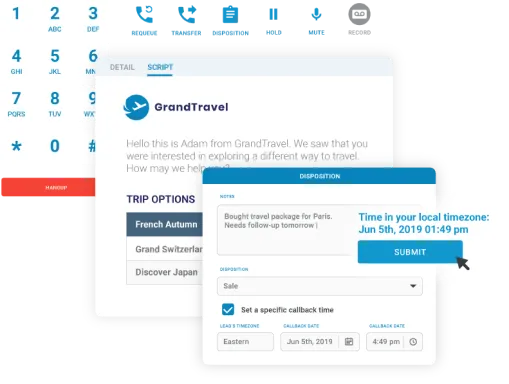

What are outbound call center dialers?
Before we get started, let’s focus on dialers in general. At their most basic, call center dialers support different outbound dialing modes used for call management and streamlining outbound calls. Outbound dialers automate the outbound dialing process so that call center agents can make more calls in a shorter time, thus broadening a business’ potential reach.
The main types of dialers are:
- Preview dialers
- Power dialers
- Predictive dialers
- Progressive dialers
Each type of dialer has its strengths. Below, we’ll outline each in more detail before weighing up the pros and cons of predictive and progressive dialers to help you pick the right dialer for your business.
A preview dialer is a type of call center dialer that allows service reps to see the next call on their list ahead of time. This means that agents have access to some customer information before a call. They can then choose whether to take the call or skip to the next number on the list.
A power dialer is essentially the preview dialer’s opposite. A power dialer dials out phone numbers one after the other automatically after each call is completed. This is great for reducing idle time, but agents have no control over the calls they take or do not take. As such, power dialers are best suited to scripted outbound calling.

Predictive dialers - pros and cons of predictive dialing
For those managing high-volume, low-margin outbound contact centers, predictive dialers are an ideal solution. In this environment, efficiency and optimizing cost per call are the most critical factors. Predictive dialers anticipate that some calls will be unsuccessful and counterbalance this by over-dialing. That means callers can be connected to sales teams the moment a line becomes available. With predictive dialing, it’s all about call volumes.
Predictive dialers dial as many potential leads as possible during an agent’s shift by making predictions about agent availability. They make calls based on an algorithm that tracks their performance metrics. This means that calls can be connected before an agent becomes available. An unanswered call is automatically connected to the next available agent.
It’s important to note that predictive dialing is not designed to support illegal outbound calling practices or spam bombardments. There are laws that control outbound dialers to protect customers from unethical contact center practices. Before deploying your new predictive dialer, it’s important to speak with your service provider and legal team to ensure that your system strategy is fully compliant with all the relevant laws and regulations.
With RingCentral Engage Voice, contact centers benefit from this predictive algorithm to guarantee more calls are getting connected and fast.
Engage Voice is an algorithm-based outbound dialing system that uses data collected from previous call rounds to calculate a dialing ratio (or pacing ratio)—in other words, the number of calls per agent. There are tons of great features included in the platform, including our Dynamic Script Studio, IVR Studio, inbound call routing, chat, and analytics.
Plus, the predictive model is constantly being analyzed and remodeled in real-time so that agent productivity and efficiency can continue to improve.
Cons
- Sometimes cause calls to reach prospects before an agent is available to pick up
- Produces potential delay in response time from agents
- Risks agent burnout
Pros
- Can call multiple phone numbers simultaneously
- Enable agents to be more productive/ minimize idle time
- Achieve more calls with fewer agents
- Leave a voicemail and move on to other clients with answering machine detection

Progressive dialers - pros and cons of progressive dialing
A progressive dialer is not entirely dissimilar to predictive dialing. The progressive dialer dials the next call number on a set call list after an agent completes the previous call. As such, the wait time from one to the next number is removed so that agents can work more productively and complete more calls during their shift.
Progressive dialing reduces time wasted between calls. But, unlike a predictive dialer, the progressive dialer doesn’t make multiple calls at once before an agent is available. It only sends through as many inbound calls as there are agents available.
This means that progressive dialers can’t make as many calls as predictive dialers. But that’s not necessarily a bad thing. While predictive dialers risk leaving customers waiting without an agent to talk to, progressive dialers ensure that agents will be available.
As such, progressive dialers are best suited to situations where agents make multiple calls, one after another, that are all very similar in content. A progressive phone system will optimize pace with reference to agent performance and target the most qualified leads.
With RingCentral Engage Voice, you’ll be able to maximize operational output and agency performance in your contact center. Agents are armed with the information, tools, and guidance they need to execute top-quality calls efficiently. Engage Voice’s progressive dialer optimizes dialing pace in accordance with agent availability and abandoned call rates, making it a key feature of a sales dialer solution.
Cons
- May mean agents lack time to gather customer information between calls
- Can cause agents to have to work through many numbers before reaching a live person
- Produce lower dialing rates and reach than predictive dialers
Pros
- Reduce customer hang-ups
- Allow for more personalized interaction
- Display prospect history and information on agent screen
- Increase agent efficiency & talk-time
- Connect live agents to more customers

Predictive dialers vs progressive dialers: which dialer is right for your call center software?
At first glance, when choosing a dialer, predictive dialers and progressive dialers are not all that dissimilar, with their automatically dialing capabilities. But there’s one crucial distinction. Predictive dialers prioritize the number of calls, whereas progressive dialers prioritize call quality and customer experience.
As such, predictive dialers are best suited for contact centers that want to expand their agent’s reach as much as possible. Progressive dialers are best suited for contact centers that still want to optimize their efficiency and ensure that the quality of interactions between their agents and customers is maintained at a high level.
Predictive dialers, therefore, are best for volume. Perfect for en masse outbound calling, telemarketing, and call outreach. On the other hand, progressive dialers are the call distribution system most appropriate for a business that wants to streamline its operations while improving customer interactions and reducing call abandonment rates.
The difference between progressive and predictive dialers is not a matter of right or wrong. You’ve just got to pick a dialer that meets your business needs. That’s why RingCentral offers several auto dialer solutions for businesses of all shapes, sizes, and operational requirements.
Progressive dialer vs predictive dialer - which will it be?
To wrap up, auto-dialers make great outbound call center solutions. They can be mobilized in any cloud contact center and integrated with your contact center software, harnessing the power of VoIP technology to improve agent efficiency and productivity.